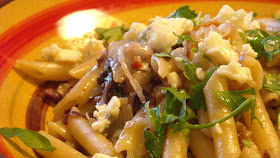 I had just gotten back from a booze filled Saturday night at the Oregon Coast and I was craving some comfort food. For 24 hours I had indulged my inner redneck and survived on a diet of Coors light, Ruffles, chicken thighs slathered in KC Masterpiece BBQ Sauce and a 10 lb. Salmon that was cooked on a grill so rusty from salt air that it looked like it might crumble to a pile of dust before the salmon was ready to eat.
I had just gotten back from a booze filled Saturday night at the Oregon Coast and I was craving some comfort food. For 24 hours I had indulged my inner redneck and survived on a diet of Coors light, Ruffles, chicken thighs slathered in KC Masterpiece BBQ Sauce and a 10 lb. Salmon that was cooked on a grill so rusty from salt air that it looked like it might crumble to a pile of dust before the salmon was ready to eat.For fiber we had those plastic trays of pre-cut veggies and ranch dip (I tried to force down some broccoli so my colon wouldn't get completely packed with chip and chip by-products).
What is almost surreal is that in the middle of all this "crap" we were shoveling in, we also uncorked a rare Turley White Coat, a 1997 Ridge Pagani Zinfandel a 2005 Dusi Vineyard Zinfandel from Tobin James and a Four Graces Willamette Valley Pinot Noir (the first three wines were great, I only remember popping the cork for the last...I think I went for a nap about that time...in anticipation of playing blackjack all night at the Gearhart Fireman's Ball (think keg party, 70's cover band with blackjack and a homemade roulette wheel.
By the time I got home on Sunday I just wanted to cook something comforting.
You know, something that touches all of the taste senses- sweet, salty, savory, bitter, sour.
Tonight's dinner hit all but the sour component and it was only my lack of motivation for making a salad that made that not happen.
When I looked in the refrigerator tonight I had a head of radicchio, a little bacon, some Italian Parsley, Gorgonzola and I knew I had a sweet onion in the pantry. This is a pasta dish that I threw together on the fly and it is nice to see that I still had my wits about me after a Hunter Thompson-esque previous 24 hours
The next time you are contemplating fast food, take a quick look in your pantry, you might surprise yourself at what you have ready to go in the time it takes to boil the water for pasta.

Penne with Bacon, Caramelized Onion, Wilted Radicchio and Gorgonzola
Ingredients:
1 head Radicchio (thinly sliced)
1 sweet onion (thinly sliced)
4 garlic cloves (thinly sliced)
1/4 lb. bacon (1/2 dice)
Italian Parsley
1/2 cup Gorgonzola
1 lb Penne Pasta
Directions:
In a large pot add a splash of olive oil and cook the bacon (add some pepper flakes if you want some heat) until browned and crisp and then remove the bacon, reserve in a small bowl and throw in the onions and garlic to caramelize. When the onions are soft and brown pull them out of the pot and reserve in a small bowl as well.
When you pasta is done, crank the heat on the pot and throw in the radicchio to wilt, this will take just a minute or so. Toss back in the onions, bacon and penne w/ some pasta cooking water to combine everything. To serve, go ahead and place the pasta in warm bowls and sprinkle with the Italian Parsley and Gorgonzola crumbles.

Pair with some toasted garlic bread and a good Italian Chianti .
Buon Appetito'

























